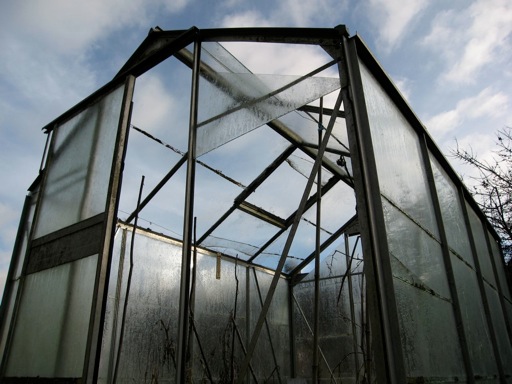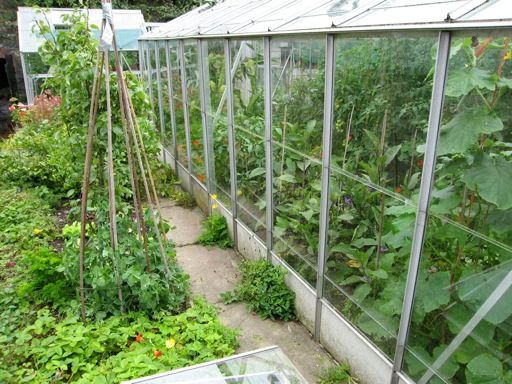In a garden near you there’s a greenhouse looking for love – and giving it a new home would make your ‘gardening footprint’ a few sizes smaller.
“Will you stop peeping?” Joining me for a walk at this time of year sooner or later drives
my companions to utter this corrective phrase (or something blunter) as their patience
slowly ebbs away. It always starts out well: swaddled against midwinter’s chill, we
trundle off for ‘some fresh air’, but it’s not long before my ulterior gardening motives
kick in. “Just a sec,” I say, craning over a hedge, “hang on a minute,” causing the
marching posse to halt as I peek through yet another gap, or a hole in a gate. “Oh, come
on,” comes the disgruntled chorus as I’m dragged from my peephole.
I always set out on winter wanderings with good intentions. I vow not to peer into other
people’s gardens to see what winter veg they’re growing, whether they got the leaves up
before year’s end, or if there’s a forest of dreary dead stalks or drifts of dazzling, sun-
catching winter stems. But I just can’t help myself – I’m a curious gardener (okay, nosey)
and in this skeletonised season, when our gardens are laid bare for all to see, my curiosity
wins out. I prefer midwinter to midsummer: you can’t have a decent nose at other
people’s gardening goings-on when everything’s lush and leafy.

But what really fires my gardening imagination, even on a tooth-achingly cold day, is the
glinting sight of glass, or more precisely structures made of metal, wood and glass:
greenhouses. My heart lifts when I spy winter salads or spring bulbs coddled under
cover, while grimy-green structures in need of a good scrub down leave me forlorn. And
where a greenhouse is not being used to grow things, where it’s little more than a single-
cracked-pane-left wreck – I always see something else: untapped potential. Where others
see a dumping ground for what won’t shoehorn into the shed, I see an opportunity to roll
out some of the earth-friendly gardener’s favourite ‘r’s: repair and/or recycle, and then
tap into some free and renewable modern sunshine.
If one of your gardening resolutions is to go greener to trim your ‘gardening footprint’,
then a ‘preloved’ greenhouse is for you; second-hand structures come with unexpected
oodles of ‘added greenness’. For a start, they don’t need making again, which cuts down
on energy use at the manufacturing end of things; buying a brand new greenhouse sends
out a fresh call for the energy and resources needed to manufacture, transport, sell and
install it. If your preloved prize comes from just a few streets away, the muscle-powered
wheelbarrow sees off any transport emissions, while rebuilding it will give your grey
matter a welcome workout. Going preloved keeps stuff ‘in the loop’, where it can earn its
keep indefinitely. It is one of the cornerstones of a landfill-less life.
Techniques for acquiring your preloved sunshine-harvesting unit – aka greenhouse – can be selected to suit your personality. Brazen types will simply knock on the door and ask if there’s a greenhouse out back needing a new home (check it’s an unloved one first by doing some winter wandering). More timid techies might scan ‘gifting’ websites such as Freecycle or Freegle for free-to-collect greenhouses (or post a request saying you’re on the lookout for one), or you can stick to the old-fashioned method of scanning the local paper’s small ads. A ‘wanted’ card in a local shop or on a community notice board is always worth a shot. And, unless you’re skint, it’s even worth paying for a preloved ‘buyer collects’ greenhouse; it will cost a fraction of a shiny new equivalent.
Don’t expect preloved to be shining perfection. Although you might be lucky and happen
on one with a sound frame and its original glazing, chances are you’ll get something in
between, with a decent frame and some glass missing (or about to depart). But don’t let
any superficial ramshackledness put you off, unless it’s a timber frame that you can sink
your fingers into (in which case, there’s always the option of reusing the glass to make
some sunshine-catching garden cloches).
If yours is ‘dismantle and collect’, you can confound a trick-playing memory by taking
photographs and by labelling the components with a waterproof pen. Be careful when
handling glass, and keep nuts, bolts, clips and the like in logically labelled bags. Preloved
greenhouses are unlikely to come complete with a construction manual (if they do, pay
homage to the greenhouse gods).

Miracles aside, it’s not that taxing to restore a second-hand solar harvester to its former
glory. A search online for ‘greenhouse spares’ will shower you with options from an
impressive range of suppliers of anything from simple wire glazing clips to shiny new
panes of glass (or acrylic or polycarbonate if you’ve gone for a preloved ‘plastic’ model).
Web-weary gardeners might find that the traditional technique of asking a local garden
centre selling greenhouses for help with spares works a treat. There’s going to be some
cuss-laden hair-pulling at times, but there is expertise – local or virtual – available on tap
to help you get your lean, green, reduced-footprint sun-catcher up and growing.
One thing a preference for the preloved isn’t going to do is put those who make new
greenhouses out of business. If anything, it’s quite the reverse. Another insight that my
stop-start winter walks give me is how quickly changes in one garden can ripple out into
others. When a previously neglected greenhouse has undergone a retrofit and has turned
from junkyard to joyous growing space, or where a second-hand one has been put up, it’s
amazing how often new, yet-to-be-loved greenhouses quickly appear on neighbouring
plots. Of all the things that could hop from one garden to another, the timeless allure of
greenhouse growing is surely the most welcome.
Giving downtrodden greenhouses a new lease of life doesn’t just turn our collective
gardening efforts a shade greener, it can inspire others to enjoy the multiple rewards of
growing powered by renewable, pollution-free sunshine.
Fancy a walk?
Text and images © John Walker


